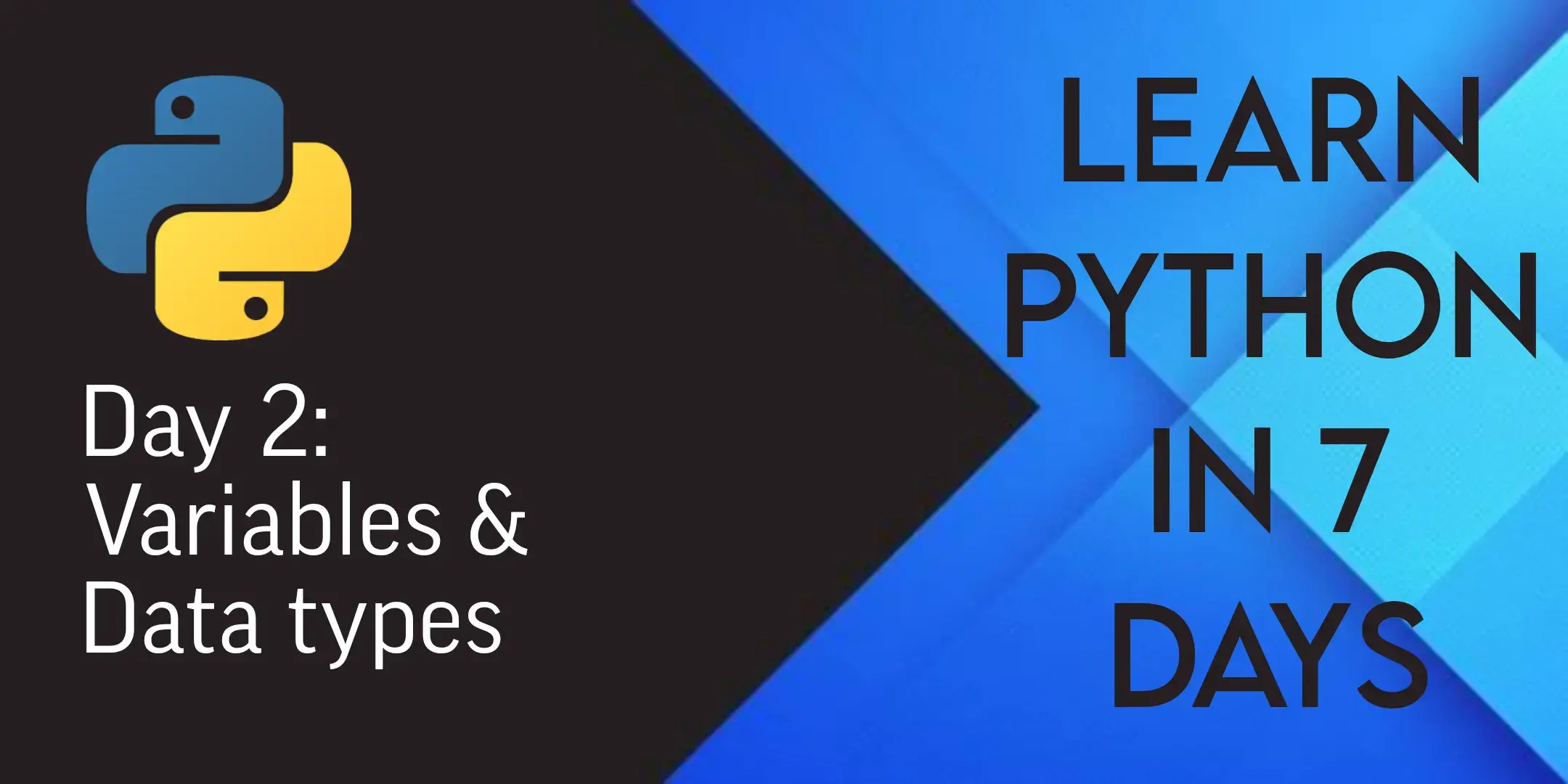Learn python in 7 days: Day 2 - Variables & Data types

Shashank Shetty
Comment section
You need to be a subscriber to comment

List of contents:
Variables
Variables in Python are similar in many ways to variables
in mathematics. Variable is a character(s) that acts as a placeholder and
contains some value or information. A characteristic feature of variables
is that, they vary! Their value is not fixed. In Python, variables are
defined by assigning value to them using the = symbol, called
as the assignment operator. They can be used in place of the value
they contain, i.e., they behave as if they are indifferent from their
value.
x = 7 # The variable x is defined with the value of 7
y = 10 # The variable y is defined with the value of 10
print(x) # Gives the same output as print(7)
print(x + y) # Gives the same output as print(7 + 10)
x = 5 # Changes the value of x from 7 to 5
print(y - x) # Gives the same output as print(10 - 5)
Variables need not be single letter. It is important to note that although
variable names may contain numbers, they cannot begin with one.
Underscores are allowed and later versions of Python also allow you to use
special unicode characters such as π; yet, some special
keywords are reserved (class, def, is, in, not, etc.) and trying to name a
variable using them will result in an error. Variables in Python are case
sensitive, meaning result is different from
Result or REsulT, which can be both useful and
annoying.
Though rarely used, variables can also be deleted using del.
Another variable with the same can be created afterwards.
strength = 87 # Creates a variable strength with the value of 87
print(strength)
del strength # Deletes the variable strength
print(strength) # Gives an error, because strength is not defined any more
Data Types
Not only numbers, variables can be given any value. Try the following code:
name = Shetty777
print(name)
The above code should give an error! Because python doesn't know what
Shetty777 is. However, enclosing the word in quotes (single
or double) will make it a string and Python doesn't care what the
contents of a string are (for most cases, there are some special
characters which you'll get to know). Now try to run the above code, but
with name = "Shetty777"
Values in Python must be ones that belong to a data type.
type(data) is used to get the data type of a value in Python.
There are numerous data types in Python, but we are concerned about the
basic built-in data types. They are:
Numeric types: int, float, complex
Sequence types: str, list, tuple
Mapping type: dict
Set types: set, frozenset
Boolean type: bool
None type: NoneType
Integer
As the name suggests, the int type is the data type of
integers, simple as that. E.g., 7, 100, 0, -46, 11 + 5
Float
Decimal numbers upto a precision of 15 decimal digits are stored as
float. E.g., 3.7, 0.0628, 4 - 8.33, 2.997e8
Complex
The mathematics students among you might know that the root of -1 is
i and numbers containing it are termed as complex numbers. The only
difference is that the letter j is used in its place. E.g., 5
+ 2j, 0 - 4j, 0j
String
String type is just text, and it can contain unicode characters like π,
α and λ. str is defined by surrounding the
characters by either single or double quotes, but not a combination of the
two. E.g., '', "Hello", 'Python is awesome!', "It's so cool", "θ"
List
Unsurprisingly, a list is a list of values. It is defined
using square brackets and the elements are separated by commas. Lists can
have elements of different types; they can have duplicates; they are
mutable (modifiable). E.g., [0, 1, 2, 3], [7, 'Apple', 9j, ['a', 'b',
'c']]
Tuple
A tuple is basically a list, but it is immutable, meaning the
values of elements cannot be changed. Elements cannot be added or removed
either. They are defined by round brackets and the elements are separated
by commas. Why would you want to use them? They are much more efficient in
storing information. They can have duplicates; they can contain different
types of elements. E.g., (7, 2025, 4, 899), ('Shashank', 16, 0.005)
Dictionary
A dict in Python holds pairs of information in the format
key:value. The values can be accessed by the keys with the
syntax dict[key]. They can also contain different data types;
they are mutable; but cannot contain duplicate keys. They are declared in
curly brackets and the pairs are separated by commas. E.g., {0: 89, 1: 46,
2: 99, 3: 95}, {"name": "Shashank", "age": 16, "height": 1.56, 777: "blog
site"}
Set
A set is basically a very efficient list. It cannot contain
duplicates, if there are two elements with the same value, only one will
be stored. They are unordered/not indexed; they can contain elements of
different types; the elements are immutable, but you can add
(set.add(element)) or remove
(set.remove(element)) them. They are defined by curly
brackets, with elements separated by commas.. E.g., {"Ruby", 3.1415,
"Millie", (x, y, z)}, {10, 20, 10, 30, 40}
Frozenset
A frozenset is almost indifferent from a regular set except
that it is immutable as well. It is defined with the syntax
frozenset({elements})
Boolean
There are only two bool values: True and
False. Think of it as Yes or No. They will be useful in
conditional statements. In fact, True is just a placeholder for 1 and
False for 0; they are synonymous.
NoneType
The NoneType is a special type in Python which is used to
represent the absence of a value. It is similar to null in other
programming languages. It is the data type of None and is not
the same as 0. 0 is an integer whereas None is... literally nothing! This
is used for debugging and safely handling empty data.
You can convert between data types using the target type as a function.
There are limits of course, E.g., str(111) is valid whereas
int("Hi") is not. Try different combinations for yourself.
More to know
- Python is a dynamically typed language, meaning you do not have to specify the data type of the value when creating a variable; Python will detect it automatically. Not only that, the data type of the value can be changed as well. However, it is good practice to use type hints, which are basically notes that convey the type of the variable. It is not necessary at all and Python doesn't care about it, in fact, you can label them incorrectly without getting an error; but using them makes the code more readable to others. Type hints can be employed to functions as well and throughout this course, the use of type hints will be encouraged.
score = 99 # Python detects the type of score as int
print(score, type(score))
score = "A+" # Python detects the type of score as str
print(score, type(score))
subject: str = "Science" # Type hinting the variable subject as str
marks: dict[str: int] = {"Physics": 100, "Chemistry": 95, "Biology": 98} # Type hinting the variable marks as dict with str keys and int values
a, b = 5, 10 # Same as a = 5; b = 10
print(a, b)
a, b = b, a # Swaps the values of a and b
print(a, b)
numbers: list[int] = [1, 2, 3, 4, 5] # Creates a list with the elements 1, 2, 3, 4 and 5
print(numbers[0])
text: str = "This is fun!"
print(text[2:7]) # Prints the elements from index 2 to 6 (7 is not included)
print("Apple\nBanana\nCherry") # \n is used to create a new line
print("Apple\tBanana\bCherry") # \t creates a tab and \b removes the previous character
print('ISRO\'s Chandrayaan-3\\Aditya-L1') # Using \ before characters that affect a string stops their effect, including another \.
name: str = "Shashank"
age: int = 16
print(f"Hello, my name is {name} and I am not {age + 10} years old.")
input(). Here is
an example:
a: str = input("Enter a number: ") # The input is always a string, so it must be converted to the desired type
b: str = input("Enter another number: ")
print("The sum is: ",int(a) + int(b))